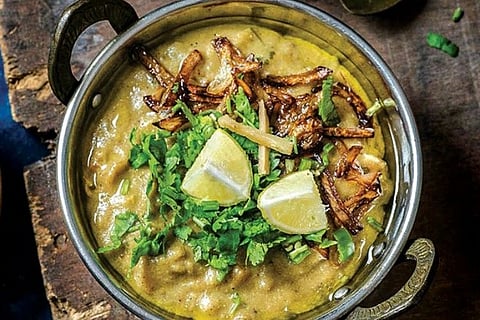

It’s Ramadan season. Every evening, the streets in Hyderabad are overcrowded with people queuing up in front of haleem shops for a plate of the gooey mutton delicacy, eaten mostly to break the day-long fast during Ramadan. Haleem is usually a mix of wheat and lentils with mutton cooked slowly until the meat becomes tender. It is then served with a dash of lime, crispy fried onions and dry fruits, garnished with coriander leaves. And one restaurant that is famous for its authentic haleem is Pista House, also popular for its Hyderabadi biryani.
This year, giving a twist to the scrumptious dish, Pista House has decided to add Chakhao, a variety of black rice sourced from Manipur. A collaborative effort between Pista House and the NorthEast Foundation, black rice is said to be high in nutritional value and was commonly consumed by Chinese royalty owing to its health benefits.
In India, though rice is a staple food, the production and consumption of black rice is restricted to the North-East. It is extensively grown in Odisha, Jharkand and West Bengal, and costs around Rs 300 per kg in local markets.
Haleem is served after the first sighting of the crescent moon during Ramadan and is known for its richness in taste. It is seldom considered to be a health supplement but with the addition of black rice, this time haleem is going to be a prefect starter for religious believers who piously follow the day-long rigorous fast.
What is black rice?
Tracing the history of black rice, this exotic variety of rice was once known as the ‘forbidden rice’. The secret behind the name dates back to when Chinese royalty withheld every grain of the rice from public consumption. The reason cited by many for this was the exceptional health benefits that the rice provided – from being a natural detoxifier to reducing the chances of obesity.
In ancient China, the rice was grown by royalty in small amounts and under strict supervision. But now in India, though it is still grown in patches across the country, the rice is largely consumed as a dietary supplement. Known as Chakhao in Manipuri, it’s also grown in parts of Tamil Nadu and is called Kavuni.
On the commercial aspect, researchers have time and again advised state governments to switch to black rice cultivation, as it is grown organically and consumes less water compared to hybrid rice varieties. Agricultural scientists say that by providing infrastructure, market support and financial incentives, black rice can be beneficial for Indian rice producers.
Black rice in haleem
Speaking to TNM, Deepa Agarwal, a Hyderabad-based nutritionist, says that rice has always been a hot topic of discussion among dieticians. While some say that shunning rice altogether is an option, alternatives like brown rice, red rice, quinoa and black rice are definitely healthier options.
“Black rice is traditionally known to keep diabetes at bay. It’s rich in fibre and helps in bowel movement, and to stop diarrhoea and constipation. Considering the hectic lifestyle that we lead today, black rice acts as a natural detoxifier and often helps in reducing the risks of obesity,” Deepa adds.
Black rice in haleem, according to Deepa, is a healthier alternative in comparison to wheat that is usually the main ingredient in the dish.
“Haleem is a dish rich in proteins considering the huge quantities of mutton that goes into its making. Black rice will make it a perfectly balanced dish, as it is rich in fibre and will not lead to problems of bloating or acidity. Also, as Ramadan is falling during peak summer, black rice cools down the stomach and negates the heat that meat produces in one’s body. Also, with the addition of black rice, vegetarian haleem can slowly become more popular,” Deepa says.
“But remember, black rice isn’t a miracle cure,” Deepa warns. “Switching to a healthy alternative is not easy and it takes a lot of time to adjust to the taste, texture and colour of the rice. So it is always advisable to introduce black rice in smaller portions and I think adding it to a delicious dish like haleem will definitely have a lot of takers who want to opt for this healthier alternative.”